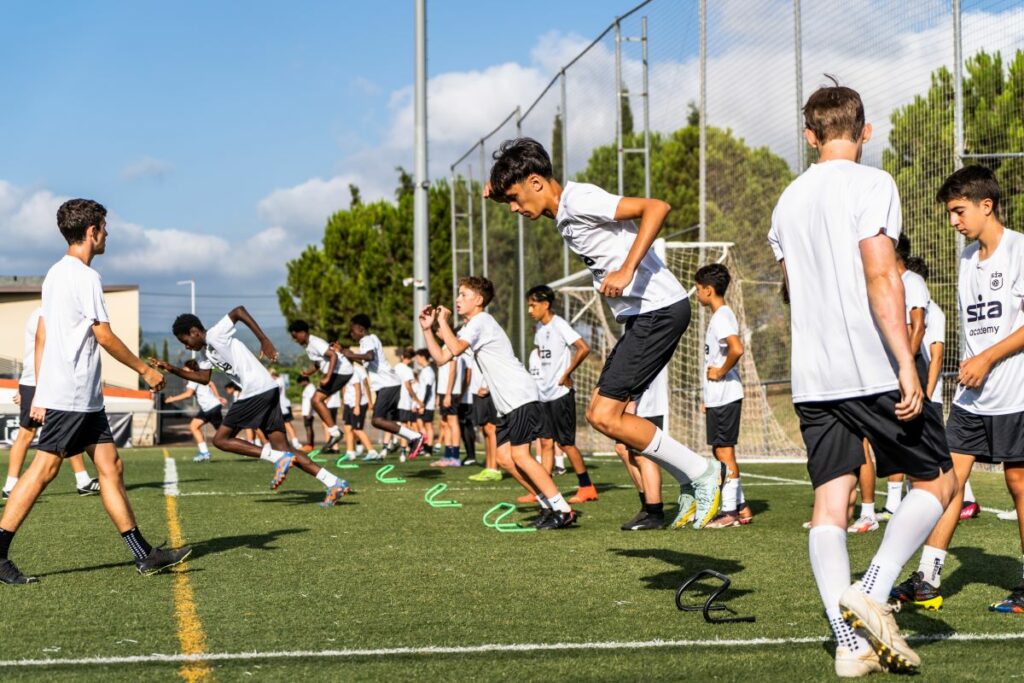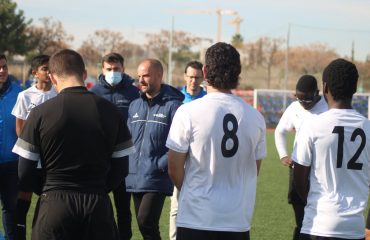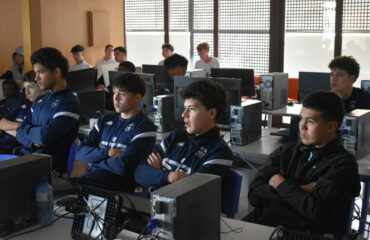The warm-up is a fundamental part of the physical and mental preparation before any football match. Although it is often seen as a repetitive routine, its purpose goes far beyond just preventing injuries. A good warm-up prepares the body for the upcoming physical effort, optimizes performance, and helps players mentally focus on the game. In this article, we’ll explore how the perfect warm-up should be structured before a football match and how SIA Academy’s approach meets this need, ensuring players reach their full potential.
Table of contents
Why is a good warm-up important?
Before a match, the body needs to transition from a resting state to one of maximum activation. This is achieved through a series of exercises that gradually increase heart rate, blood circulation, and muscle temperature — all essential elements to prevent injuries. Additionally, a proper warm-up improves neuromuscular coordination, muscle elasticity, and reaction speed, which are crucial for any footballer facing the sport’s physical and technical demands.
The warm-up also has an important psychological component. It helps players focus on their tasks, activate concentration, and reduce anxiety before entering the pitch. When a team feels physically and mentally prepared, its overall performance improves significantly.

Structure of the ideal warm-up
A well-designed warm-up should include several key phases. Below, we break down each of them and explain how SIA Academy integrates these elements into their training to optimize player performance.
1. General activation: the beginning of the process
The initial phase of the warm-up aims to raise overall body temperature. To do this, players perform activities that gradually increase heart rate, such as jogging or mobility drills. At SIA Academy, this phase goes beyond simply running in a straight line. Coaches guide players through activation movements like jumps, lateral movements, and dynamic stretches, all designed to prepare joints and muscles in a football-specific way.
It’s important that this phase not be too intense, but instead gradually activate the cardiovascular system without causing early fatigue. SIA Academy uses circuits that mimic the movements players will perform in the game, ensuring the body gets accustomed to what’s to come.
2. Joint mobility: crucial for injury prevention
One of the most distinctive characteristics of a good warm-up is joint mobility. This phase focuses on increasing flexibility in key joints that will be used during the match: ankles, knees, hips, and shoulders. SIA Academy incorporates specific joint mobility exercises to ensure players have adequate range of motion. This is essential for preventing injuries like sprains or muscle strains, which are common in football due to the quick direction changes and intensity of movement.
3. Muscle activation: engaging the key muscle groups
Once body temperature and joint mobility are at optimal levels, it’s time to activate the specific muscles that will be used during the match. This phase focuses primarily on the legs, core, and upper body muscles.
SIA Academy is known for using drills like short sprints, plyometric jumps, and reaction exercises. These movements not only enhance muscle power but also stimulate the mind-muscle connection, helping footballers be more aware of their body and respond faster during the game.
Pre-match muscle work ensures that the muscles are ready for the intense load of football, a sport that demands quick direction changes, jumps, bursts, and endurance over 90 minutes.
4. Technical and football-specific drills: the transition into the game
A warm-up should never be isolated from football. It should include drills that closely resemble the actions players will perform during the match. At SIA Academy, this is achieved through ball-based exercises that allow players to work on technical skills while still warming up. These include dribbling, quick passing, ball control, and shooting, making the warm-up more dynamic and sport-focused.
This kind of specific work not only enhances technical ability but also helps players enter “match mode,” adjusting their minds to the demands of the game. Additionally, this phase allows for tactical adjustments based on the team’s strategy.
5. Dynamic stretching and mental preparation
The final part of the warm-up should include dynamic stretches that keep the muscles active and flexible without overly relaxing them. Static stretching is not recommended right before a match, as it may reduce muscle power.
Moreover, mental preparation is essential. At SIA Academy, a brief tactical or motivational talk is given to reinforce mental focus. This helps players align with the match strategy, boost confidence, and reduce anxiety.
A proper warm-up not only prepares the body but also prepares the player’s mind, ensuring they feel focused, motivated, and mentally ready to face the upcoming challenge.

The role of nutrition in warming up
It’s important to mention that nutrition plays a crucial role in performance during both the warm-up and the match. Before a match, players must be well-hydrated and have consumed foods that provide fast energy, such as low-glycemic carbohydrates. SIA Academy emphasizes the importance of a proper nutritional plan, recommending that players eat a light, balanced meal 2–3 hours before the match to avoid any stomach discomfort.
Staying hydrated throughout the warm-up is also key. Dehydration can affect muscle performance efficiency, increasing the risk of injury and lowering overall performance.
The importance of consistency in warming up
Another essential point is consistency. Warming up isn’t something that should only be done before a match — it should be a daily routine in a player’s physical preparation. SIA Academy ensures its players maintain a consistent approach to warm-ups, making each session a step toward better physical and technical development.
Regular warm-ups allow the body to adapt to football’s demands and maximize performance each time. Plus, they help establish healthy habits that prevent long-term injuries.






